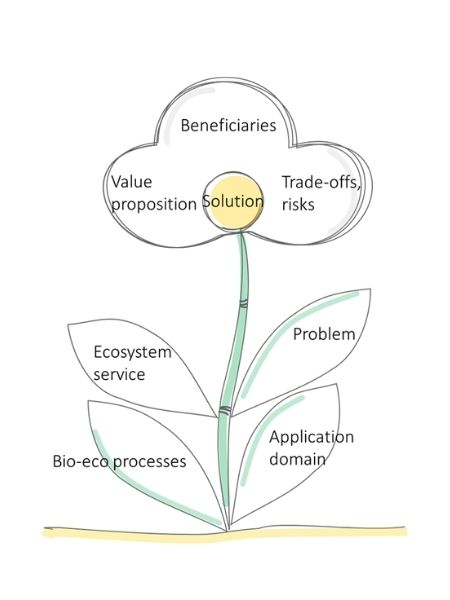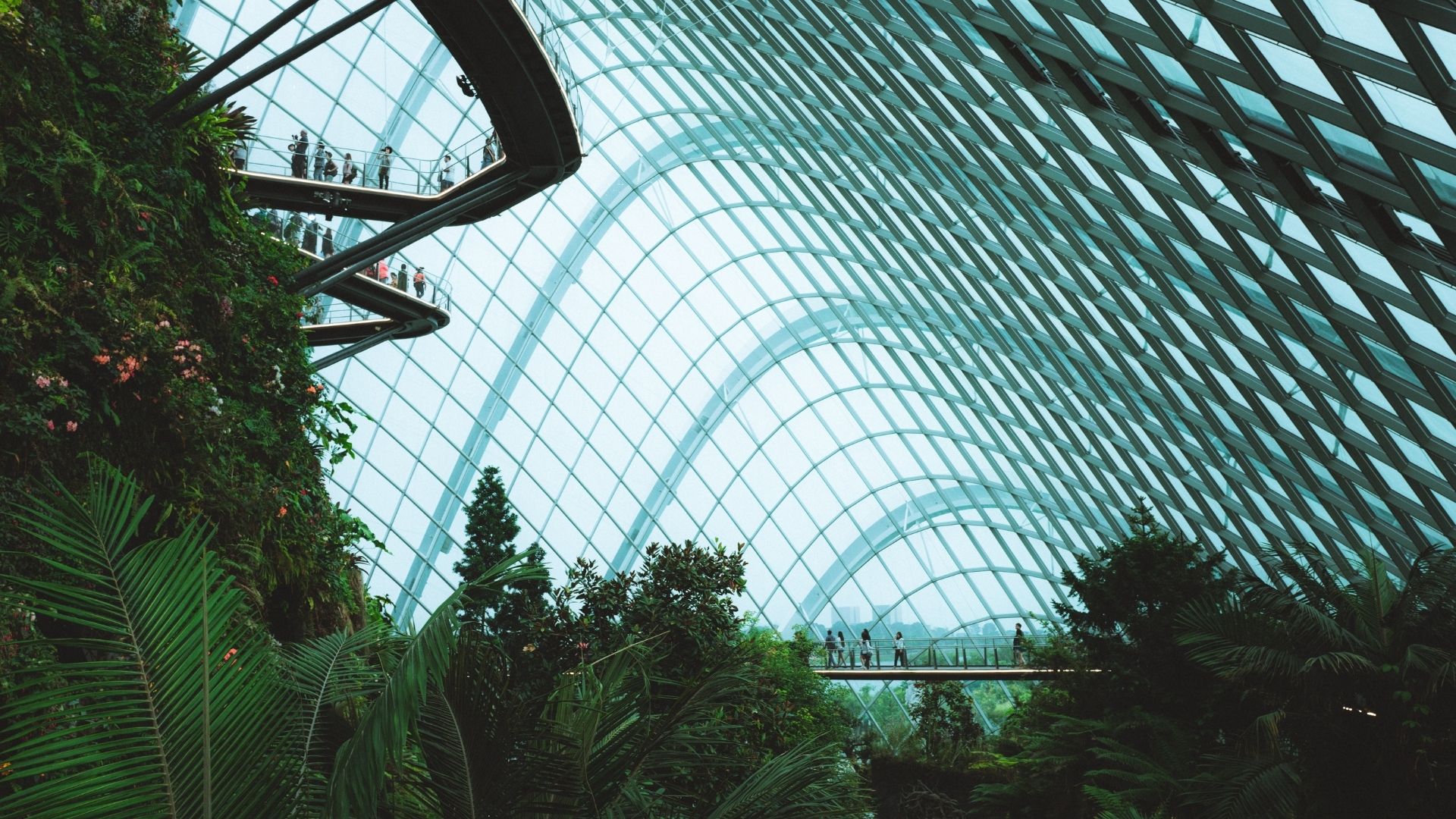NATURE-BASED SOLUTIONS CANVAS
A visual tool for NbS co-creation
Urban designers, planners and architects are increasingly exposed to a trend that encourages building with nature in addition to brick-and-mortar. Nature-based solutions (NbS), green infrastructure and ecosystem services are all concepts that explore how ecological, biophysical, and biochemical processes can actually solve engineering and socio-spatial problems [1]. Whether it is a constructed wetland that retains and cleans stormwater [2] or nano gardens that reduce heatwaves through evapotranspiration [3], NbS offer viable instruments to enhance the resilience of the built environment, while providing attractive places for people, plants, and animals alike.
Designing with nature, however, is not a straightforward task. First, it requires a collaborative, integrated design process, where an ecological knowledge base meets and interacts with various engineering disciplines from early on.
Furthermore, long-term maintenance, use, and exploitation strategies can make or break the performance of the ecosystem services offered by nature-based solutions [4]. It is thus crucial to involve both expected users and operators of NbS to maximize positive impacts and weed out risks from the get-go. In order to demonstrate how the NbS design process works, to maximize its positive impacts, and to facilitate co-design, we created a tool: the NbS canvas.
The aim of a good canvas is to visualize the architecture of an idea in a mind-map fashion. On the one hand, the process helps articulate fuzzy concepts and half-baked ideas, encouraging us to think in a certain structure to get to the next level. On the other hand, a filled-out canvas is also a great communication tool for further discussion and elaboration, as stakeholders can reflect on them critically in group co-design sessions. Canvasses are used for a wide variety of reasons from developing business models, startups, stakeholder analyses, as well as visualising complex system dynamics. So why isn’t there a canvas for nature-based solutions?
Relying on our 10+ years of experience in participatory design, nature-based solutions, and holistically sustainable built environment in general, we started to collect the nuts and bolts of nature-based solutions and arranged them into a narrative structure.
Our basic idea was to inspire thinking on two parallel strands: the ecosystem strand and the engineering strand. We strongly believe that there is fertile ground in the intersection of these two mindsets into which new NbS ideas can be seeded. The two main strands (ecosystem and engineering) are further broken down into blocks that can be explored individually and come together as the solution itself. Following these blocks offers a structured way to brainstorm new NbS or to investigate how established NbS could work in your local context.

Figure 1. Blank nature-based solutions canvas
A quick explainer of each canvas item:
- Application domain
The most compelling reason to invest in NbS is their capacity to either substitute or enhance the performance of an engineering solution. The first step on the engineering strand is to find out what actions and what functionalities we have at hand. The best is to follow a larger-to-smaller logic when establishing your application domain. Figure 2 demonstrates how we applied NbS to the domain of energy modelling in the biodome of Budapest [5].
- Problem
Problems can be technical, if tied to the functioning of an engineering solution (e.g., improving the efficiency of solar panels), or in more general cases, they can respond to user needs directly (e.g., treatment of runoff water). Be sure to consider that NbS are multifunctional and deliver multiple benefits, thus they can respond to multiple problems. For the modelling example, we targeted the performance gap between predicted and actual energy consumption of the biodome, especially in the case of cooling.
- Bio-eco processes
While an NbS itself caters for multiple purposes, specific problems are solved by specific natural phenomena, which is why it is crucial to identify them one by one. These include biophysical (e.g., erosion protection of roots), biochemical (e.g., the metabolic breakdown of plastics in Ideonella sakaiensis), and ecological processes (e.g., marine roots providing habitat for water-cleansing bacteria). Each process should be matched with a problem to understand their purpose and pave the way for their valuation. In the biodome, this underlying process was the evapotranspiration of vegetation.
- Ecosystem service
Ecosystem services are the results of bio-eco processes and incorporate all benefits applicable to humans. This step is the reformulation of the processes into an idea that directly and intuitively responds to the problem. In general, ecosystem services can be categorized as provisional, regulating, cultural, and supporting. It is useful to make a mental note of this classification, as it will have implications on how people will interact with NbS. In our example, water release from plants cools the air, thus vegetation functions as a temperature and humidity regulator.
- Solution
The solution itself is the architectural or urban intervention that creates new ecosystems or maintains existing ones. The intervention should consider all processes listed earlier, and conceptually describe how these processes are maintained on the long term. Understanding and quantifying the effect of evapotranspiration on indoor environmental parameters has allowed us to incorporate this solution in the energy modelling of the biodome.
- Value proposition
As the process focuses on more technical strands, it is also necessary to consider how the benefits translate to value that someone is willing to pay for. The value proposition is based on the benefits and gains offered by the ecosystem service. However, in order to translate this to value, the „customer” must also be considered. Value depends on who the beneficiary is, which of their problems we are solving, and how they prioritize tackling this problem. Thus, the value proposition must be a reflection on the pains and gains of specific beneficiaries, using the ecosystem services. As for the example, having the capability to count with the cooling effect of vegetation allowed us to decrease the size of the HVAC system, reducing building costs.
- Benecifiaries
Multiple beneficiaries can be identified, as long as there is a value proposition for each of them. It is recommended to visually distinguish between these linkages within the canvas. In the case of the biodome, both visitors and facility managers benefit from relying on plants as natural conditioners of indoor comfort.
- Trade-offs & risks
Finally, it is important to note that the complexity and multidimensionality of NbS can be both an asset (think co-benefits) and a source of risks. It is thus necessary to itemize what we trade off by replacing or enhancing a streamlined engineering solution and what potentially new difficulties we introduce. For the biodome, this meant introducing more complexity and uncertainty. Vegetation is heterogeneous, changes over time, and relies on maintenance to have the intended effect – something facility managers need to be aware of.

Figure 2. Filled out canvas for computing the cooling effect of plants in energy modelling
Why use canvasses?
So why bother with developing a canvas, when one can rely on rich databases of existing NbS projects, each offering categorizations of NbS functions? While these references are an important source of inspiration, facilitate benchmarking and enable us to see good practices, this is only part of the picture. First, your project will have a very specific ecological, socioeconomic, and technical context. Similarly, the peculiarities of the problems you intend to solve will be unique, so will be the eco-arsenal you can realistically rely on. Second, the richness of what nature can do and already does for us is so much greater than the semi-standard solutions explored in these databases.
NbS design will always rely on cross-cutting creativity. The more ways we can leverage them, the better stewards of nature we will become. We hope to accelerate this process by sharing simple tools, like the NbS canvas, for future reference. If you are further interested in how to build with nature, check out some of our content about NbS or the references provided, and if you need a deeper dive or have a specific project, contact us and we can help you reach your NbS ambitions.
Author
Viktor Bukovszki – Senior Consultant at ABUD; Cand. Techn. Urban Design (AAU), BSc in Architectural Engineering (YBL)
References
[1] https://www.iucn.org/theme/nature-based-solutions
[2] Woods Ballard, B, Wilson, S, Udale-Clarke, H, Illman, S, Scott, T, Ashley, R, Kellagher, R (2007):.The SUDS manual. London: CIRIA. https://www.ciria.org/ItemDetail?iProductCode=C753F&Category=FREEPUBS
[3] Kabisch, N., Frantzeskaki, N., Pauleit, S., Naumann, S., Davis, M., Artmann, M., Haase, D., Knapp, S., Korn, H., Stadler, J., Zaunberger, K., & Bonn, A. (2016). Nature-based solutions to climate change mitigation and adaptation in urban areas: perspectives on indicators, knowledge gaps, barriers, and opportunities for action. Ecology and Society, 21(2). http://www.jstor.org/stable/26270403
[4] Schmalzbauer, A (2018). Barriers and success factors for effectively co-creating nature-based solutions for urban regeneration. Deliverable 1.1.1, CLEVER Cities, H2020 grant no. 776604. https://clevercities.eu/fileadmin/user_upload/Resources/D1.1_Theme_1_Barriers_success_factors_co-creation_HWWI_12.2018.pdf
[5] https://abud.hu/portfolio/biodome-budapest-zoo-and-botanical-garden-extension/



